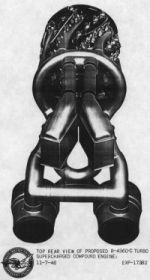

Variable Discharge Turbine Case History
The USAF Repeatedly Shoots Itself in the Foot
Source Material Prepared by the Historical Office Executive Secretariat
Air Materiel Command, Wright-Patterson Air Force Base, Ohio
January 1950
by Ethel M. De Haven, Historian
Compiled by Kimble D. McCutcheon
Published 7 Jan 2024
 Consolidated B-36C VDT Engine (P&W) |
Sanford Alexander Moss (23 Aug 1872 – 10 Nov 1946), a University of California, San Francisco and Cornell University educated General Electric gas turbine engineer, first applied the idea of extracting exhaust energy from a reciprocating engine and using it to drive a compressor that would maintain sea-level (or higher) manifold pressure at altitude. In 1918, Moss installed a turbosupercharger of his own design on a Liberty 12 aircraft engine and demonstrated that it worked at Pikes Peak, Colorado. Years later, after GE had perfected turbosuperchargers, aircraft engine designers began thinking of doing more with wasted exhaust energy than just altitude supercharging – they wanted to feed some of the exhaust energy back to the propeller, creating a compounded engine with more power and better specific fuel consumption (sfc). As the materials from which gas turbine blades were improved, they started actual experiments. The National Advisory Committee on Aeronautics (NACA) also was keen on compounding, publishing NACA Technical Report Numbers 786 in 1944, 1447 in 1947, 1735 in 1948 and 1802 in 1848. |
Powered by phpBB © 2001, 2005 phpBB Group |